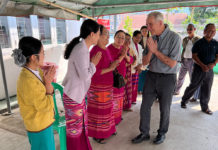UPTick’s downgrade
Editor: As staff writer Rollie Atkinson states in last Thursday’s article about UPTick’s relocation to Healdsburg, “some highly visible demolition work” has indeed exposed the vintner’s missed opportunity to engage in the historic significance of Healdsburg’s agrarian landscape. The modest roadside bungalow of the early 1900s is forever lost to make way for a new tasting room that appeals to the client’s “Mid Century Modern” aesthetic. The architect, James McCalligan, adds “agrarian” to this architectural label, a placation that exposes his client as yet another gentrifier displacing local character.
Demolition of historic buildings is almost a routine in Healdsburg. A stone’s throw across Dry Creek and from what I call UPTick’s Downgrade, a classic farmhouse fell after a brief boarding of its windows and doors. Its loss was only a few year’s ago. Within the past two decades, manufactured homes and too few vines to merit any gain in production have replaced several Victorians on Westside and Dry Creek Roads. Their individual losses might not seem significant, but the landscape they inhabited was altered toward more commercial and outside interests.
Over the years, I have heard from tourists and locals alike the appreciation for Sonoma County’s unique, casual and sometimes quirky approach to viticulture. By contrast, the same people tell me that Napa is just too commercial for their tastes. What is our county’s trajectory when we continue to loose our cultural heritage by way of demolition?
What exactly do UPTick’s owners, Steve and Robin Black, mean when they say, “we didn’t find the building suitable for commercial use,” after its former owners recently adapted the bungalow for its reuse as a tasting room? The Black’s quick dismissal of the buildings suitability highlights two misconceptions. First, they miss how so many area vintners conduct their successful businesses in modest facilities, complete with barnyard Old Yellers and rusted out farm equipment. Yet equally at loss is the creativity that begins by working with available resources. The National Trust for Historic Preservation has proven in their Preservation Green Lab that “saving and reusing historic buildings helps create a greener, more sustainable future.” Pay attention, LEED certification seekers!
The people of Sonoma County can sit idle and watch how the landscape and even their quality of life continue to evolve, for better and worse, in the name of progress. Yet there are choices here that can include retention of our historic character and heritage while succeeding in supporting tourism and agriculture. As demolitions continue, where do we stand relative to the wrecking ball?
Now is the time to save our historic places, where each community in Sonoma County protects their unique identity, heritage and their sense of place. Visitors know our place in the world is unique…isn’t it time we listen?
Thomas Eddy
Windsor
Honor Flight
Editor: I recently had the wonderful experience of going on an“honor flight” to Washington D.C. It’s a program financed usually by veterans’ organizations (but never the government) for World War II veterans to see the veteran monuments and memorials in Washington and Arlington area. A couple of my friends had gone and came back with glowing reports of their royal treatment, so I applied and nearly a year and a half later I got the call to go. We’d be flying from Sacramento on Southwest Airlines with the North Coast Honor Flight, which originated in Eureka and was financed by the patriotic citizens of the Eureka area.
I was the only female veteran with 33 male vets, threeguardians (who helped with wheelchairs, etc.) and two leaders, Mary and Steve, who did all the planning and were so good at keeping everyone happy and together. In the three days together, the 39 in our group were like family.
The first day was mostly taken up in travel. Once we got to Dulles Airport we were bussed to our hotel for a late dinner and finally bed. The next day, Saturday, was the great bus tour all around Washington and Arlington, stopping at the Vietnam Wall, Korean Memorial, Arlington Cemetery, Lincoln Memorial, World War II Memorial (where Mike Thompson met with our group) and the Women’s Memorial just outside Arlington Cemetery. We got to see the precise precision of the Changing of the Guard as well as lots of government buildings. At Dulles Airport the next morning we saw the Endeavor space-shuttle sitting atop its 747 jet, where it had been for four days. Altogether a very tiring but memorable weekend.
At the beginning I mentioned two friends who had gone on honor flights earlier. They are both members of the local units of WAVES National, a nationwide organization that welcomes Navy, Coast Guard, and Marine women, Veterans or on current duty. We meet monthly in Petaluma with potluck lunch after. We’ve lost several members recently and would like to increase our numbers. We have some younger members (they’re not all old like me!) and we need younger blood with creative ideas. If you are interested or know someone who might be, please call me, Bettie Crandall 838-4035.
Bettie Crandall
Windsor
Hop Kiln
Editor: The County’s action last week to reject plans for a commercial office and event complex at Hop Kiln Winery was a victory for protecting our historic and rural character. The Board of Zoning Adjustments rejected a plan to build a 17,000 square foot event and office building immediately adjacent to the historic Hop Kin Winery, one of Sonoma County’s most iconic structures. Nearly every resident of Westside Road attended the hearing. It is heartening to see that County officials were responsive to the calls by residents, farmers, cyclists, and even some wineries to protect an established historic district and limit commercial development in agricultural areas. The Board’s action was led by Jason Liles, Fourth District Supervisor Mike McGuire’s appointee to the Board.
On August 16, the Board will review plans for a winery expansion at Hop Kiln. While a winery development is compatible with agriculture under the County’s General Plan, one has to wonder how many more wineries and tasting rooms can be built along Westside Road before it destroys the rural character, is too congested for motorists and unsafe for cyclists. According to the County’s records there are already 25 wineries and tasting rooms permitted along Westside Road with a total production of nearly 600,000 cases annually. At some point the County has to look at the cumulative impacts of overdevelopment on the rural areas surrounding Healdsburg.
Marc Bommersbach
Healdsburg
48.6
F
Healdsburg
April 21, 2025







